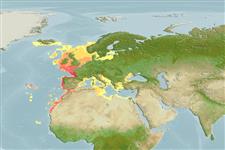Actinopterygii (ray-finned fishes) >
Perciformes (Perch-likes) >
Callionymidae (Dragonets)
Etymology: Callionymus: Greek, kallion, comparative of kallos = beautiful + Greek, onyma = name; with a better name . More on author: Linnaeus.
Environment / Climate / Range
Ecology
Marine; demersal; depth range 5 - 430 m (Ref. 5968), usually 5 - 30 m (Ref. 27115). Temperate; 16°C - 20°C (Ref. 27115), preferred ?; 65°N - 16°N, 32°W - 32°E
Eastern Atlantic: southern Iceland and Norway south to Mauritania, including the northern Mediterranean, Gibraltar, and Algeria, western Black Sea, Aegean and Adriatic Sea, Azores and the Canary Islands.
Length at first maturity / Size / Weight / Age
Maturity: Lm 17.4 range ? - ? cm
Max length : 30.5 cm TL male/unsexed; (Ref. 59122); 25.0 cm TL (female); common length : 15.0 cm TL male/unsexed; (Ref. 3397); max. reported age: 7 years (Ref. 72462)
Dorsal
spines
(total): 4;
Dorsal
soft rays
(total): 8-10;
Anal
soft rays: 9. Gill opening dorsal. Usually antrorse (forward-pointing) tip at base of preopercular spine. Rays of second dorsal unbranched except for the last, which is divided at base (Ref. 232). Snout length 2-3 times the diameter of the eye (Ref. 35388).
Occurs on sand and muddy bottoms from sublittoral to 200 m (Ref. 6444) and to 400 m or more (Ref. 9900). Feeds on small invertebrates, mainly worms and crustaceans. Territorial, males aggressive with each other. Complex courtship behavior consists of 4 phases: courtship, pairing, ascending, releasing eggs and milt. Pelagic eggs and larvae (Ref. 5968). Minimum depth reported from Ref. 27115. Neither opercular spine gland nor anterolateral glandular groove with venom gland is present (Ref. 57406).
Complex courtship behavior with 4 phases: courtship, pairing, ascending, releasing eggs and milt (Ref. 5968).
Davis, W.P and R. Fricke, 1990. Callionymidae. p. 921-924. In J.C. Quero, J.C. Hureau, C. Karrer, A. Post and L. Saldanha (eds.) Check-list of the fishes of the eastern tropical Atlantic (CLOFETA). JNICT, Lisbon, SEI, Paris; and UNESCO, Paris. Vol. 2. (Ref. 6941)
IUCN Red List Status (Ref. 115185)
CITES (Ref. 94142)
Not Evaluated
Human uses
Fisheries: minor commercial; aquarium: public aquariums
More information
ReferencesAquacultureAquaculture profileStrainsGeneticsAllele frequenciesHeritabilityDiseasesProcessingMass conversion
Tools
Special reports
Download XML
Internet sources
Estimates of some properties based on models
Phylogenetic diversity index (Ref.
82805): PD
50 = 0.5000 [Uniqueness, from 0.5 = low to 2.0 = high].
Bayesian length-weight: a=0.01122 (0.00887 - 0.01419), b=2.75 (2.69 - 2.81), in cm Total Length, based on LWR estimates for this species (Ref.
93245).
Trophic Level (Ref.
69278): 3.3 ±0.38 se; Based on food items.
Resilience (Ref.
69278): Medium, minimum population doubling time 1.4 - 4.4 years (K=0.43-0.47; tmax=6).
Prior r = 1.52, 2 SD range = 1.14 - 2.04, log(r) = 0.42, SD log(r) = 0.15, Based on: 1 M, 1 K, 2 tmax, records
Vulnerability (Ref.
59153): Low to moderate vulnerability (29 of 100) .
